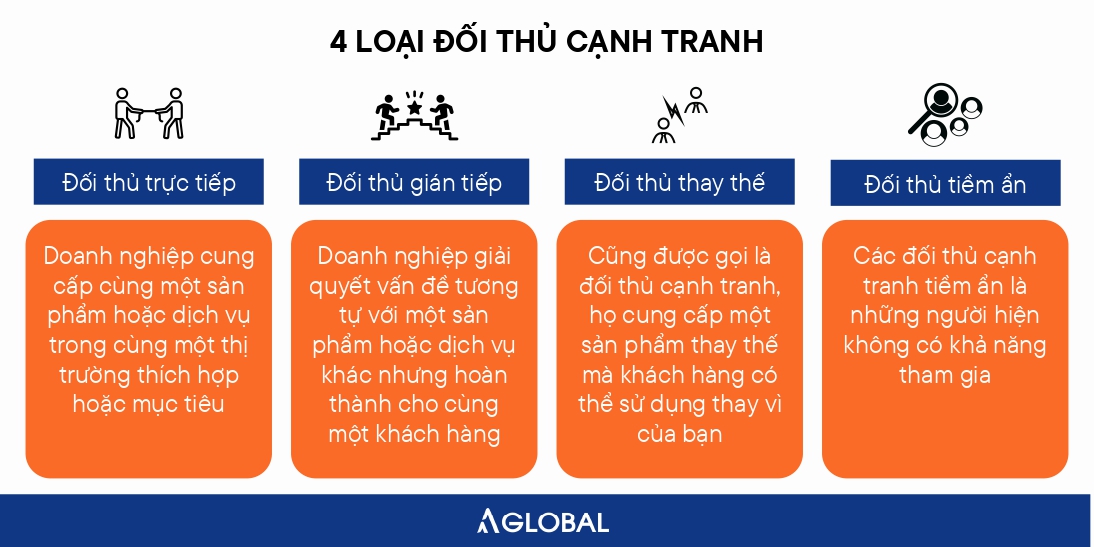
Understand what competitors are in e-commerce
What are competitors? For businesses, competition is a basic rule for economic activities to survive and develop. The fact that administrators clearly understand what their competitors are will bring a suitable and effective competitive strategy for the brand. Let's clearly portray this specific object in the article below.
1. What are competitors?
Competitors are companies or individuals who can provide the same or similar products and services to the business's customers. Competitors' characteristics are: homogeneous customer files, satisfying the same consumer needs and directly affecting the business's market share.
 Coca-Cola vs. Pepsi and classic confrontations
Coca-Cola vs. Pepsi and classic confrontations
Researching and analyzing competitors helps businesses have a detailed view of the advantages and limitations of their competitors and themselves. Thereby helping businesses improve their capacity and competitive strength.
For example: Some outstanding "rivals" couples, competing strongly for a long time:
-
Entertainment industry: DC vs. Marvel
-
Fast food industry: McDonald's vs. Burger King
-
Technology industry: Apple vs. Microsoft
-
Aviation industry: Airbus vs. Boeing
2. Classify competitors
When learning what a competitor is, many people mistakenly think that only businesses that compete directly are competitors. However, in reality, the competitive "map" also appears "more than one" other dangerous "conflict of interest" objects. Those factors include:
2.1. Direct competitors
This is the group of competitors with the most powerful influence, capable of dominating the business's position in the market. Because they share similar market segments and needs, direct competitors have the ability to drive innovation, improve products/services, and provide detailed customer “insight” for the brand.
Through observing and researching direct competitors, we will assess their weaknesses and the business strategies they are implementing. From there, we strongly develop product differentiation, attract customers and lead the market.
Some famous pairs of direct competitors include:
-
Sports goods industry: Nike vs. Adidas
-
Carbonated beverage industry: Pepsi vs. Coca Cola
2.2. Indirect competitors
Indirect competitors may be units in other industries or with different products/services, but solving the same problem for customers as the business. Is a suitable alternative solution that customers can choose during the shopping process.
For example:
-
McDonald's vs. Pizza Hut
-
Vietnam Airlines vs. VinBus
 Sellers need to have a solid foundation of competitors to stand firm in the market
Sellers need to have a solid foundation of competitors to stand firm in the market
In the process of finding out "what a competitor is", indirect competitors will increase the business's deep understanding of the market. Thanks to that, it helps promote activities to improve and upgrade products and services as well as further expand services for the brand.
We can clearly see this through the AI battle of businesses today. Most companies are promoting AI integration into products and services to keep up with the market and upgrade customer experience.
2.3. Alternative opponents
As the name suggests, substitutes have the ability to provide different products/services while still satisfying the business's user needs. In other words, they have the ability to replace your product.
Substitute competitors have a certain impact on the market and consumer shopping habits. Being aware of the presence of substitute products will help businesses always improve, diversify products and maintain good market position.
2.4. Potential competitors
Finally, the last factor in understanding "what the competition is" of a business is potential competitors. These are businesses/units that have just joined or are not yet present in the market (but have the ability to participate).
For example:
-
Suntory Pepsico vs. Vinamilk
-
Suntory Pepsico vs. TH True Milk
In terms of role, potential competitors play an important role in building a business's long-term development plan. It is a decisive factor in the leading role in market share of an enterprise.
In-depth understanding of potential competitors encourages business owners to continuously innovate, ensuring the products provided to the market have the most value and uniqueness. Thereby improving the competitiveness of products and businesses.
3. What is the role of competitor analysis?
Competitor analysis not only affects short-term business strategies, but is also decisive in the long-term direction of manufacturers in the market. To clearly understand the role of competitors, managers need to understand and answer these 5 questions:
-
Who are the business's competitors?
-
What is their strategy?
-
What are their development goals?
-
What are your competitors' strengths and weaknesses?
-
How do our opponents tend to react to the strategy we will use?
Mastering the above core issues, businesses will understand what advantages and disadvantages they have compared to their competitors. From there, come up with effective competitive attack and defense strategies and measures for each type of competitor.
Besides, they help managers avoid mistakes and limitations that competitors make when building business strategies. At the same time, promptly adjust the business's weaknesses.
At a higher level, based on the available research, business owners can predict their competitors' next strategies. From there, deal and respond promptly.
Read more: Instructions for building the latest business plan for 2024
4. 6 steps to analyze competitors on e-commerce platforms
The seller clearly understands what the competition is and its importance. So what is the competitor analysis process?
4.1. Identify competitors
Businesses need to identify and classify their competitors. They will need to classify each target group instead of specifying all competitors. Because for e-commerce, it is an extremely difficult and impossible job.
As for direct competitors, this is the most confrontational object. Therefore, sellers need to clearly identify each specific object for research.
4.2. Product analysis
Sellers can analyze this factor from the following angles:
Width of product range:
-
Number of different product categories?
-
Do they sell a variety of products or only focus on a specific niche?
Depth of product range:
-
Do they offer a variety of designs, sizes, and colors for each product?
New product:
-
Do they regularly launch new products?
Product inventory:
-
Are products often out of stock?
Product quality:
Check customer feedback to evaluate product quality:
-
Are customers satisfied?
-
Is the product the same as the sample and description?
Learn more: What is a potential product? 5 steps to identify potential products
4.3. Price analysis
Price - a sensitive factor - is clearly disclosed on the trading floor. Therefore, consumers can easily compare prices between stores to choose the most suitable product. Businesses need to clearly understand this situation to build a competitive pricing strategy through the following factors:
Pricing model:
-
Do they set prices that are fixed or fluctuating?
-
Do prices fluctuate based on supply and demand?
-
Are prices adjusted based on geography?
-
Do they regularly offer voucher codes and loyalty programs?
Price point:
-
Is the competitor's price higher or lower than the business's price?
-
If lower, how do they do it?
-
If higher, what other value do they provide?
4.4. Research marketing strategies
Marketing is an integral part of business. Building an effective marketing strategy will help businesses surpass competitors and hold market advantage. Observe and come up with appropriate strategies.
-
Do competitors use advertising?
-
How do they run ads?
-
Do they use multi-channel for business?
4.5. Evaluate customer service
“Personalizing” customer experiences has become an important factor for businesses when retaining customers. To upgrade services for businesses and evaluate the quality of competitors, we can:
-
Experience your competitors' services
-
Review customer care and support policies
4.6. Research the business situation
Finally, the seller needs to see an overview of the competitor's business situation: revenue, sales, return rate. These data help brands most intuitively and effectively assess the status of their competitors.
5. Conclusion
Understanding what competitors are in e-commerce will help businesses improve their competitiveness and position in the target market. From there, build an effective long-term business strategy and sustainable growth.
Accompany businesses to sell effectively on Amazon. Connect with us here to receive free 1-1 consultation from AGlobal's leading experts.
AGlobal - Amazon's account management, advertising and education partner in Vietnam, helping more than 200+ units export goods simply, streamlined and effectively.

